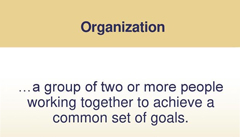 They all have passions and interests – core values that drive them. I’m talking here about corporations, businesses, foundations, places of worship, community organizations – any type of organization that you interact with as a non-profit.
They all have passions and interests – core values that drive them. I’m talking here about corporations, businesses, foundations, places of worship, community organizations – any type of organization that you interact with as a non-profit.
We tend to think of an organization or company as a cold, sterile place that has no heart or personality – when, in fact, it has both.
Think about it this way.
How does an organization come into being? It always gets started when one or more human beings decide there is a business opportunity or a cause or a belief that would and could be positively pursued and cultivated, if there were an organized way to do it.
The successful organizations that grow and thrive are led by people who carefully protect and nurture the core values of the organization they started. There is a definite culture and set of beliefs embedded in the culture. There are specific biases, interests and leanings. There are certain ways of doing things; there are rules and expectations on performances. There is a clear understanding of what not to do.
All of this forms the organization’s personality, just like a human being. And that personality has specific interests and passions.
Take what I have written so far, and test it against the companies you do business with. Or, if you’re a person of faith, your place of worship. Or the community organization you belong to. Or the foundation you are working with.
You will soon realize that, in fact, all of these organizations have a set of passions and interests that drive how they think and act.
This is an important point if you’re dealing with a corporation, business, foundation or organization in your major gift work. It’s important because, just like an individual donor, you must go through the following steps with an organization donor:
- Need to qualify – Just like an individual, not all organizations will want to engage with you. Why? Because their passions and interests don’t match what you do, or they don’t perceive you as a worthy partner for their charitable work – or any number of other reasons. You must qualify the foundation, corporation or organization you intend to work with.
- Identification of passions and interests – An organization has these, as we just established; you need to ask a decision-maker what they are. They will be interested in funding programs that meet their passions and interests.
- Caseload size – While we recommend 150 qualified donors for an individual caseload, with organizations the caseload size depends on the complexity of the organizations on it. For instance, an MGO working for one of our clients has 12 organizations on his caseload, with an annual value of $8 million dollars. The organizations are so complex and time-consuming that the MGO only can handle twelve.
- Tiering – You still need to tier your caseload of organizations. They all have different economic value and therefore need various levels of attention, stewardship and cultivation.
- Setting Goals – You need to set a goal for each one. What do you hope to achieve in revenue from each organization you are working with? It is important to decide what that number is.
- Creating a plan – You must have a personalized plan for every organization on your qualified caseload. There is one nuance here that is different from an individual caseload plan: with organizations, while there is one leader for their giving, there is also a group behind that leader that participates in the decision. So your plan must address the leader AND the group.
- Asking – With organizational funding you do need to go through the hoops that the organization has set up. They are more formal, and there are more decision-makers. So, your ask will have to fit into their system. But all the same elements of the ask are the same: how what you do fits what they are interested in, description of compelling need, a believable solution, and how the organization fits into addressing the need. Don’t let their process and forms force you to be less emotional and human. This is a common failure in organization fundraising. Describe what needs to be done in human and emotional terms. Believe me, it will work.
- Reporting back – They also want to know that their giving made a difference. Fail at doing this, and you will find that the organization will not continue to give to your non-profit.
- Measure value retention – Just like with individual donors, you can measure retention and attrition of value. Recently, we did some analysis of a MGO’s foundation caseload. What we found was a loss of $6 million over two years from solid foundations who had not been managed properly. All of this was hidden because the giving from NEW foundations covered up the loss.
As you’re thinking about your organization [read corporate and foundation] fundraising this year, don’t let yourself think that they are substantially different than your regular friendly and caring individual donor. They aren’t. And that’s why you still have to behave the same. (Tweet it!)
Richard





Richard, I couldn’t agree more with your points and nice of your to write out, if only in summary, the steps and action items. Someone who is motivated will have plenty to chew on and at least get their head around how to get started with a sound plan. Thanks, Derry Deringer